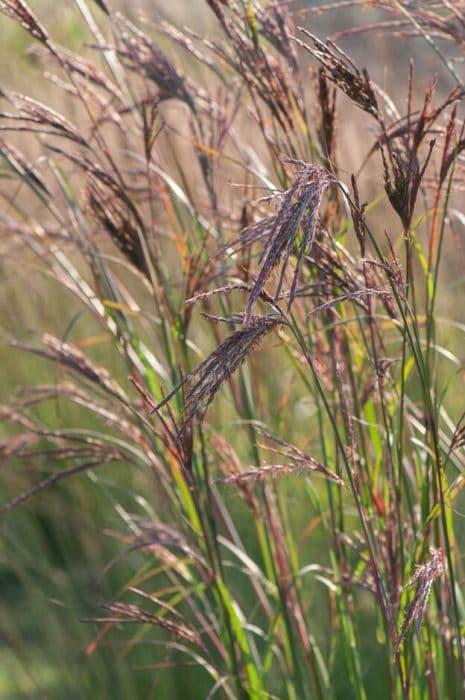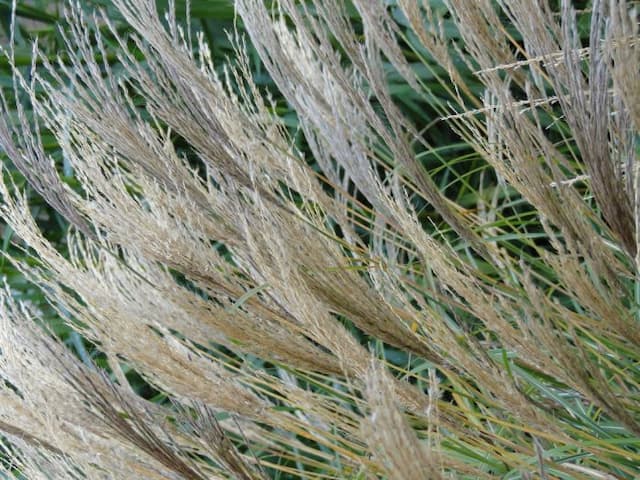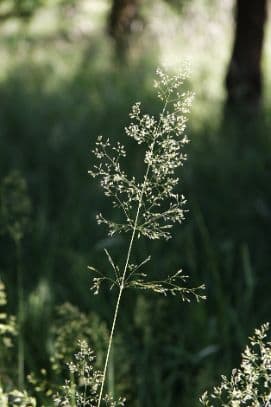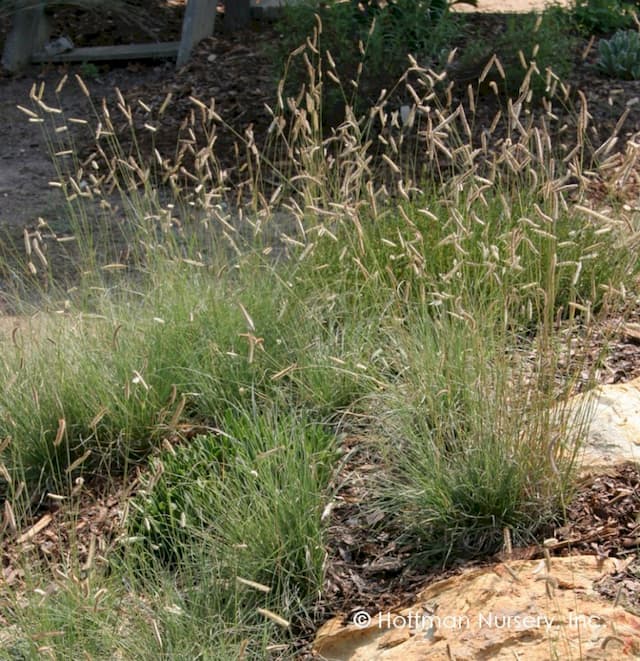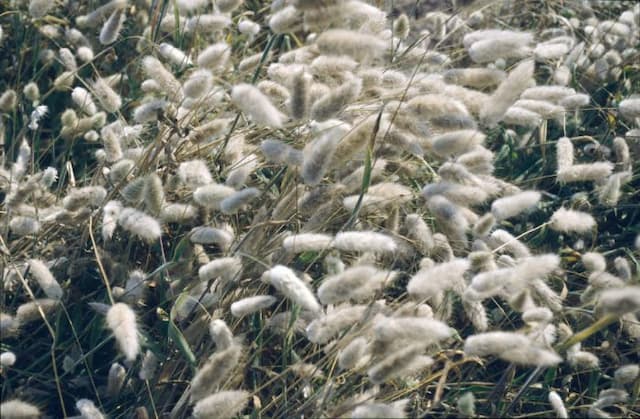Serrated tussock Nassella trichotoma

ABOUT
Nassella trichotoma, commonly known as serrated tussock, is a perennial tussock-forming grass characterized by its fine, hair-like leaves which are green to grey-green in color. The tips of the leaves are often tightly curled, and the plant has a distinctive serrated feel when the leaves are run through fingers due to small teeth along the edges. Serrated tussock has a dense and fine-leafed tussock habit, which gives it a somewhat wispy appearance, especially when blowing in the wind. The flowers of serrated tussock are borne on tall, slender flowering stems that emerge from the tussock base. These stems are topped with narrow, spike-like seed heads that start out greenish but mature to a pale cream or straw color. Each individual seed is tiny and attached to a delicate, hair-like structure which aids in wind dispersal. The overall effect of the plant in the flowering season is quite feathery and airy. During different seasons, the color of serrated tussock may change, ranging from the vibrant greens of new growth in the spring to the duller tones during the winter months. Despite these changes, the plant consistently retains its fine texture and dense tussock shape, making it recognizable in various landscapes.
About this plant
 Names
NamesFamily
Poaceae.
Synonyms
Serrated Tussock, Nassella Tussock, Argentine Needle-grass, Mexican Feather Grass, Uruguayan Tussock Grass.
Common names
Stipa trichotoma, Stipa neesiana, Oryzopsis trichotoma, Urachne trichotoma, Nassella trichotoma var. neesiana, Stipa neesiana var. minor
 Characteristics
CharacteristicsLife cycle
Perennials
Foliage type
Deciduous
Color of leaves
Green
Height
2 feet [0.6 meters]
Spread
1 foot [0.3 meters]
Plant type
Grass
Hardiness zones
7
Native area
South America
Benefits
 General Benefits
General Benefits- Erosion Control: Nassella trichotoma, commonly known as Serrated Tussock, has a deep and extensive root system that helps to stabilize soils and reduce erosion.
- Livestock Feed: Although not highly preferred by livestock due to its low palatability, it can serve as a forage source in times when other feed is scarce.
- Habitat for Wildlife: Serrated Tussock can provide cover and nesting opportunities for small animals and birds in its natural habitat.
- Biodiversity: In areas where it is native, Serrated Tussock can contribute to the biodiversity of grassland ecosystems.
 Medical Properties
Medical PropertiesThis plant is not used for medical purposes.
 Air-purifying Qualities
Air-purifying QualitiesThis plant is not specifically known for air purifying qualities.
 Other Uses
Other Uses- Nassella trichotoma, commonly known as serrated tussock, can be used in the production of paper; the fibrous nature of the grass can be pulped and processed into a rough, organic paper.
- The grass can be used as a filler material in construction; mixed with clay or adobe, it can provide additional tensile strength to structures.
- The dried inflorescences of serrated tussock can be utilized for decorative purposes, such as in dried floral arrangements or as part of wreaths.
- It can also serve as a natural dye plant; different parts of the plant can produce varying shades of yellow or green when used in traditional dyeing practices.
- Crafters may use serrated tussock for basket weaving; although not a traditional material, its fibers can be woven into rustic baskets or mats.
- Serrated tussock can be a substrate in mushroom cultivation; when sterilized and supplemented, it could support the growth of certain fungal species.
- It can be used in erosion control practices; serrated tussock's extensive root system helps stabilize soil in areas prone to erosion.
- The plant can act as an indicator species for overgrazing or soil degradation, providing valuable information for land management and conservation efforts.
- In some cultures, serrated tussock may be used in ceremonies or rituals, symbolizing elements of the natural world or the passing of seasons.
- During times of resource scarcity, serrated tussock can be used as emergency forage for livestock, although it has poor nutritional value and can be potentially toxic if consumed in large quantities.
Interesting Facts
 Feng Shui
Feng ShuiThe Nassella trichotoma, commonly known as Serrated Tussock, is not used in Feng Shui practice.
 Zodiac Sign Compitability
Zodiac Sign CompitabilityThe Serrated Tussock is not used in astrology practice.
 Plant Symbolism
Plant Symbolism- Invasiveness: Nassella trichotoma, commonly known as Serrated tussock, is considered a highly invasive species in many regions outside its native range. Therefore, it can symbolize the spread and domination over native flora, representing the idea of uncontrollable growth or takeover in various meanings.
- Resilience: As a hardy grass that can thrive in poor soil conditions with low fertility, serrated tussock symbolizes resilience and the ability to endure and adapt to challenging environments or circumstances.
- Persistence: The capability of serrated tussock to persist in adverse conditions and to be difficult to eradicate once established can symbolize persistence and determination in the face of obstacles.
- Unwanted change: The impact of serrated tussock on agricultural land by reducing the productivity of pastures can be seen as a symbol for unwanted change or degradation, particularly in the context of environmental health or land use.
 Water
WaterSerrated tussock should be watered thoroughly whenever the soil it grows in is nearing dryness. It is not a plant that requires constant moisture, and overwatering can be detrimental, potentially leading to root rot. Generally, providing about 1 to 2 gallons of water per square yard every other week should suffice, but this may vary depending on local climate conditions and soil type. During the hotter, drier months, monitoring the soil moisture more frequently is crucial, but reduce watering in cooler, wetter periods to avoid excess moisture around the roots.
 Light
LightSerrated tussock prefers full sunlight to thrive, making it suitable for open landscapes where it can receive at least six hours of direct light daily. The best spot for this plant is in an area with clear exposure to the sky, away from taller structures or trees that could cast shade upon it.
 Temperature
TemperatureSerrated tussock is resilient and can tolerate a wide range of temperatures, but it grows best at temperatures between 40°F and 75°F. It can survive minimum temperatures as low as 20°F and maximum temperatures up to 90°F, though extreme temperatures could stunt growth or cause damage to the plant.
 Pruning
PruningSerrated tussock benefits from pruning to encourage new growth and maintain a tidy appearance. Pruning is best carried out in the late winter or early spring, before new growth begins. This plant may be pruned annually or biennially, depending upon its growth rate and the desired form.
 Cleaning
CleaningNot needed
 Soil
SoilSerrated tussock prefers well-drained soils with a slightly acidic pH between 5.5 and 7.0. A mix of sandy loam with some organic matter is ideal to mimic its natural grassland habitat.
 Repotting
RepottingSerrated tussock does not typically require frequent repotting; it can be repotted every 2-3 years or when it outgrows its current container.
 Humidity & Misting
Humidity & MistingSerrated tussock tolerates a wide range of humidity levels but thrives best at moderate humidity, common in its natural grassland environment.
 Suitable locations
Suitable locationsIndoor
Provide bright light, well-draining soil, and occasional watering.
Outdoor
Plant in sunny spot, well-draining soil, water sparingly.
Hardiness zone
7-10 USDA
 Life cycle
Life cycleNassella trichotoma, commonly known as serrated tussock, begins its life cycle as a dormant seed in the soil, which requires adequate moisture, temperature, and sunlight to germinate. Upon germination, the seedling emerges, developing roots and a tuft of fine leaves as it enters the vegetative growth stage. As the plant matures, it forms dense tussocks of wiry leaves and elongates its stem to produce a flowering stalk during the reproductive phase, typically in late spring or early summer. The flowers are wind-pollinated and give way to feathery seed heads containing numerous seeds, capable of being dispersed over long distances by wind. After seeding, the plant may enter a period of dormancy, particularly in dry conditions, but it is a perennial species that can survive for several years, resuming growth with the return of favorable conditions. Serrated tussock's ability to produce a large number of seeds and its persistence in the landscape make it a successful, albeit often invasive, grass species in various regions worldwide.
 Propogation
PropogationPropogation time
Late Winter-Spring
Nassella trichotoma, commonly known as serrated tussock, is most frequently propagated through seeds. The optimal time for sowing the seeds of serrated tussock is in the spring when soil temperatures are consistently warm enough to promote germination, which is typically above 50°F (10°C). To propagate, the seeds are scattered over a prepared soil surface and lightly covered with soil or a thin layer of mulch to ensure contact with the soil while keeping them protected from wind and surface feeding birds. The area should be kept moist but not waterlogged to provide ideal conditions for seed germination and establishment. Generally, no special treatment is needed for the seeds before sowing, although in a controlled environment, stratification or scarification might speed up germination rates.
